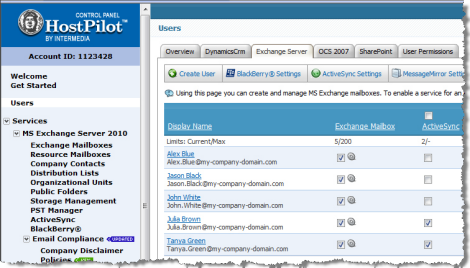Why I'm letting someone else run my Exchange 2010 server

Microsoft officially released Exchange Server 2010 today. As an MSDN and TechNet subscriber, I could go download the code for free and install it on my in-house Windows Server 2008 R2 box. But I have no plans to download those bits or install them.
Instead, I'm planning to let someone else handle the heavy lifting for me, and I suspect I have a lot of company. The biggest objection to a complex but powerful server product like Exchange is the hassle of managing it locally. Using a third-party hosting company eliminates those hassles and adds benefits like redundant data storage and simplified administration.
For the past few years, I've kept all my personal and business e-mail, calendar, and contact information in an Exchange account hosted by Mailstreet, a division of Apptix. (Previously, I used unmanaged POP/SMTP servers for e-mail and stored messages, contacts, and calendar information locally in Outlook PST files.) Mailstreet's service has been first-rate, including a recent trouble-free upgrade from Exchange 2003 to Exchange 2007. For our collaborative work on recent book projects, my co-authors and I have also been using SharePoint and Exchange 2007 as part of the Microsoft Business Productivity Online Suite, which has also been easy to use and extremely reliable.
The first third-party hosting company to cross the Exchange 2010 finish line is Intermedia, which announced availability of its hosted Exchange 2010 product (a custom-developed solution) within a few seconds of Microsoft's announcement. So far, neither Apptix nor Microsoft's BPOS division have announced definitive plans to make the latest version of Exchange available as a hosted offering. According to an Apptix spokesperson, being first isn't necessarily that big of a deal:
Microsoft has not announced an official release date for the hosted version for Exchange 2010, but as a long-time member of Microsoft's Technical Adoption Program, Apptix has been working successfully with Exchange 2010 in their lab for over a year. They will be more than ready to offer Exchange 2010 to customers once the hosted version, with the appropriate features and functionality for multitenancy incorporated, is made available - sometime next year.
Until that time, Apptix will continue to offer its proven hosted Exchange 2007 service that customers can rely on for mission-critical email communication needs. … Most end-users won’t even notice the enhancements of Exchange 2010, as the new features are primarily datacenter-centric. Microsoft’s new end-user benefits are really available in Outlook 2010, which Apptix will offer immediately to customers when it is commercially available.
I spoke last week with Intermedia's Chief Operating Officer, Jonathan McCormick, about the company's plans and its infrastructure. They currently boast a quarter-million users and expect the biggest source of growth in the hosted Exchange market – the "sweet spot" – to be companies with 200 to 500 users that are currently running the aging Exchange 2000 or Exchange 2003 and dread the prospect of an in-house migration.
Cost is an issue, of course, but data integrity is even more important to those business customers, McCormick told me: "They care about their data," he said. Those Exchange repositories don't just contain simple e-mail threads; they also include PowerPoint presentations, business contacts, and details of contracts. A server crash can paralyze the business for days, which is why Intermedia has multiple replicated platforms in data centers on opposite coasts, with rapid restore capabilities and a 100% Data Protection Guarantee.
Intermedia also touts its custom development skills, which allow them to simplify administration tasks via a custom control panel (shown here) instead of using the generic Microsoft-provided admin tools. One example is the ability to quickly perform a remote wipe of a stolen or compromised mobile device such as a Blackberry.

One misconception I had when I started investigating hosted Exchange options is that they are expensive and only appropriate for large businesses. As it turns out, most hosting companies offer plans for small companies, and both Mailstreet and Intermedia have single-user plans appropriate for sole proprietors like me. Including ActiveSync support (which works with both Windows Mobile and the iPhone) and spam filtering, I pay roughly $14 a month for a 2GB mailbox. Businesses with multiple users can get significantly lower per-user pricing.
Speaking personally, the biggest advantage of the Exchange platform for me as a small business owner is its ability to work on multiple platforms. Ironically, my recent experiments with Apple products have been especially successful with Exchange. After Mailstreet migrated my hosted account to a server running Exchange 2007, I was able to connect the Snow Leopard Mail client and an iPhone to the server and begin syncing immediately. If I send or receive a message, create or edit an appointment or contact, or trim the contents of my inbox on any PC, Mac, or mobile device (including a Windows Mobile phone), those changes are reflected on any other device. I don't have to think about synchronization, and I don't have to worry about a local server failure causing me to lose important data. Given how well my setup is working, I'm in no hurry to migrate to Exchange 2010, but will probably take a closer hands-on look at Intermedia's offfering shortly.
Clearly, Google's entry into the market (along with some very clever marketing and a halo effect from their search success) has made an impact on competitors for managed e-mail and apps, especially for small businesses. Their presence is undoubtedly responsible for Microsoft's decision to slash its BPOS prices in half recently. It wouldn't surprise me to see third-party hosting companies start cutting their prices as well.